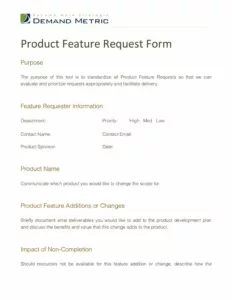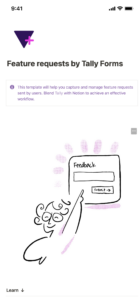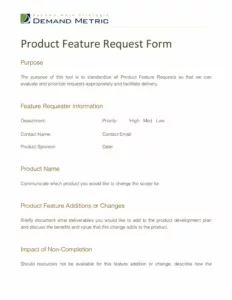Utilizing a prescribed format for these submissions offers several advantages. It minimizes ambiguity and miscommunication by providing a clear framework for requesters to articulate their needs. This clarity leads to more accurate estimations of development effort and resource allocation. Furthermore, standardized requests facilitate efficient tracking and management of the entire feature development lifecycle, from initial submission to final implementation and release.
The subsequent sections will delve deeper into specific aspects of creating, utilizing, and managing these valuable instruments for product enhancement. Topics covered will include best practices for designing effective forms, strategies for efficient processing and prioritization, and methods for integrating these requests into agile development workflows.
Key Components of a Feature Request Form
Effective feature requests require specific information to ensure clarity and facilitate efficient processing. The following components constitute a robust framework for gathering the necessary details.
1: Title: A concise, descriptive title summarizing the requested feature. This allows for quick identification and understanding of the request’s core purpose.
2: Description: A detailed explanation of the desired functionality. This should include the problem the feature solves, the proposed solution, and the expected outcome.
3: Justification: A clear rationale for the feature’s implementation. This section explains the value proposition, highlighting the potential benefits for users or the business.
4: Target Audience: Identification of the intended users or groups who will benefit from the proposed feature. Understanding the target audience aids in prioritization and design considerations.
5: Acceptance Criteria: Specific, measurable, achievable, relevant, and time-bound (SMART) criteria that define when the feature can be considered complete and ready for release.
6: Priority: An assessment of the feature’s urgency and importance relative to other requests. This aids in scheduling and resource allocation.
7: Attachments (Optional): Supporting documentation, such as mockups, wireframes, or user stories, which can further clarify the request and aid in visualization.
These components, when combined, provide a comprehensive picture of the proposed feature, enabling development teams to accurately assess its feasibility, impact, and priority. This structured approach promotes efficient processing, reduces ambiguity, and ultimately leads to more successful product enhancements.
How to Create a New Feature Request Template
Creating a standardized template ensures consistent information gathering and streamlines the feature request process. A well-designed template clarifies expectations for requesters and facilitates efficient evaluation and prioritization by development teams.
1: Define Objectives: Clearly articulate the purpose of the template and the information it aims to capture. Consider the specific needs of the development team and the type of information required for effective evaluation.
2: Identify Key Fields: Determine the essential data points needed to understand and assess each request. These typically include a title, description, justification, target audience, acceptance criteria, and priority level.
3: Select a Format: Choose a suitable format for the template, such as a digital form, spreadsheet, or document. Consider accessibility, ease of use, and integration with existing workflows.
4: Develop Clear Instructions: Provide concise and unambiguous instructions for completing each field. This minimizes confusion and ensures consistent data quality.
5: Test and Refine: Pilot test the template with a small group of users to identify any areas for improvement. Gather feedback and iterate on the design to optimize clarity and usability.
6: Implement and Communicate: Deploy the finalized template and communicate its availability to all stakeholders. Provide training or documentation as needed to ensure proper usage.
A well-structured template, coupled with clear communication and ongoing refinement, establishes a robust framework for managing feature requests. This facilitates effective prioritization, reduces ambiguity, and ultimately contributes to a more efficient and successful development process.
Standardized forms for requesting new features provide a crucial mechanism for managing product evolution and enhancement. They ensure consistent information gathering, facilitate clear communication between stakeholders and development teams, and enable efficient prioritization and implementation of requested functionalities. From the detailed description and justification to the target audience and acceptance criteria, each component contributes to a comprehensive understanding of the proposed feature’s value and technical implications.
Effective utilization of these templates empowers organizations to streamline their development processes, reduce ambiguity in requirements gathering, and ultimately deliver products that better meet the needs of their users. A thoughtful approach to template design and implementation, coupled with ongoing refinement and stakeholder feedback, represents a significant investment in the ongoing success and evolution of any product or service.


